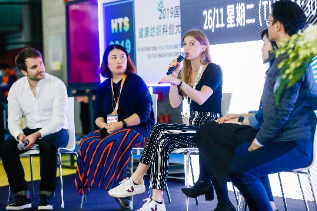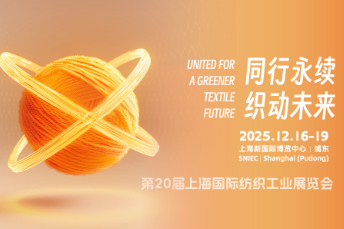ShanghaiTex Scheduled for December 16-19, 2025 Joining Hands with the Textile Industry for a Sustainable Future Opening a New Paradigm with Five Key Innovation Directions
ShanghaiTex Scheduled for December 16-19, 2025
Joining Hands with the Textile Industry for a Sustainable Future
Opening a New Paradigm with Five Key Innovation Directions
The 20th Shanghai International Textile Industry Exhibition (ShanghaiTex 2025) will be held from December 16 to 19, 2025, at the Shanghai New International Expo Centre. As an important global event long-awaited by the textile industry, this year’s ShanghaiTex will feature the theme "United for a Greener Textile Future", with a focus on five major innovation directions. Textile companies, scholars, designers, and brand innovators will join forces to reshape the industry and create new possibilities for textile craftsmanship, design, and innovation.
Collaboration Across the Supply Chain, Tapping into New Resources
In the post-pandemic era, the textile industry is undergoing unprecedented challenges and opportunities. From now onwards, ShanghaiTex is honoured to have the unprecedented support from Shanghai Textile Association, the Shanghai Federation of Industry and Commerce's Textile and Apparel Chamber of Commerce, and the Shanghai Textile Science Research Institute. This has enabled the show to have access to new buyers’ and sellers’ resources, expanding applications and gathering industry peers who are eager for innovation. Together, the organization will seek breakthroughs in this new era.
Ji Shengjun, Director of ShanghaiTex Organizing Committee, Chairman of Shanghai Textile Association, President of Orient International (Holding) Co., Ltd. said, "ShanghaiTex is our own national brand. Since its debut in 1984, it has brought enormous business opportunities to the textile industry with its unique market insights and long-term development strategies. ShanghaiTex 2025 will integrate more resources and foster innovative development. Our entire organizing committee will work with the industry to discuss macro policies, future trends, and business pain points. This will help guiding companies in adjusting their production models for a green and intelligent digital transformation which is for the enhancement of their overall competitiveness."
A Full-wing Collaboration - Focusing on Five Innovations
For companies to stand out in the new normalcy, they must focus on technological innovation, green production, and sustainable development. ShanghaiTex 2025 will be rooted in traditional segments such as spinning, weaving, knitting, dyeing, and printing technologies, while focusing on five innovation directions through featured displays and exploring new business opportunities in the process of textile industry's upgrade:
New Products – Green Fashion Materials
The display of new fibers, new materials, green production technologies, environmental protection, and recycling solutions will help the textile industry better understand the feasibility of sustainable development, gradually achieving carbon neutrality.
New Manufacturing – Intelligent Production
Artificial intelligence, automated production, and efficiency improvements are essential for companies to stay ahead in this new era. This zone will feature remote management, digital production, AI, IoT, software, and cross-border platforms, showcasing the new directions of the textile industry post-pandemic.
New Technology – Innovative Applications
Displays will include smart wearable devices, the integration of wearable products with textiles, rehabilitation products, female-specific needs across different ages, and smart safety textiles designed for the elderly and children, offering brands and designers new possibilities for product development.
New Consumption – Personalized Production Technology
On-demand production, 3D technology, customized design, and supply chain optimization will allow designers and brands to harness AI for creative and product development, leading fashion consumption toward "personalized customization." At the same time, O2O (online-to-offline) consumption models will meet the new generation's demand for individuality and new consumption patterns.
New Services – Digitalization and E-commerce
The zone will showcase new sales models, highlighting the transformation of traditional textile and apparel operations. The chain from factory to consumer will be significantly shortened. Buyers of the new generation, who focus on social media, will facilitate brands to reach younger audiences in the most effective way, offering more efficient channels for brands to engage with consumers.
T-Explorer Textile Innovation Hub
ShanghaiTex has always promoted various activities to explore the integration of new technologies and products with the industry. Building on past success, ShanghaiTex 2025 will host the "T-Explorer Textile Innovation Hub" with concurrent events to foster interactive communities and communication across industries:
Sustainable Development Series / 2nd Green Sustainability Forum
The 4th Artificial Intelligence on Fashion & Textile International Conference (AIFT 2025)
The 4th International Health Textile Technology Conference
The 2nd Textile Innovation Startup Zone
The 3rd Wearable Technology X Textile Design Competition (WTTDC 2025)
ShanghaiTex 2025 Theme Zones
T-EXplorer (New)
Spinning, Man-made Fibre & Techtextile Machinery Zone
Weaving Machinery Zone
Spare Parts and Accessories for Textile Machinery Zone
Knitting and Hosiery Machinery Zone
Printing, Dyeing & Finishing Machinery Zone
Digital Printing Machinery, Dyestuff & Textile Chemicals Zone
Event Organizers and Support
ShanghaiTex is hosted by the Shanghai Council for the Promotion of International Trade (CCPIT Shanghai), Shanghai Chamber of International Commerce (COIC Shanghai), Shanghai Textile Association, and Orient International (Holding) Co., Ltd., with organization by Shanghai Textile & Information Exhibition Co., Ltd. and Shanghai Pudong International Exhibition Co., Ltd. Co-organizers include the Shanghai Federation of Industry and Commerce Textile and Apparel Chamber of Commerce, Beijing Talent-Expo Co., Ltd., and Shanghai LinkWell Exhibition Co., Ltd., with technical support from the Shanghai Textile Science Research Institute. Alafa Conference & Exhibition Services (Shanghai) Company Limited is providing support as a supporting unit.
For more details and exhibition inquiries, please visit the official WeChat.
ShanghaiTex 2025 Exhibitor and Buyer Inquiries:
Exhibitor Inquiries:
Contact: Mr. Zhang
Phone: (86) 18930320059
Email: exhibiting@shanghaitex.cn
Address: No.43 Aomen Road, Shanghai, China
Buyer Inquiries:
Contact: Ms. Wang
Phone: (86 21) 62166365
Email: visiting@shanghaitex.cn
Address: No.43 Aomen Road, Shanghai, China
2024-11-12 16:36:04










